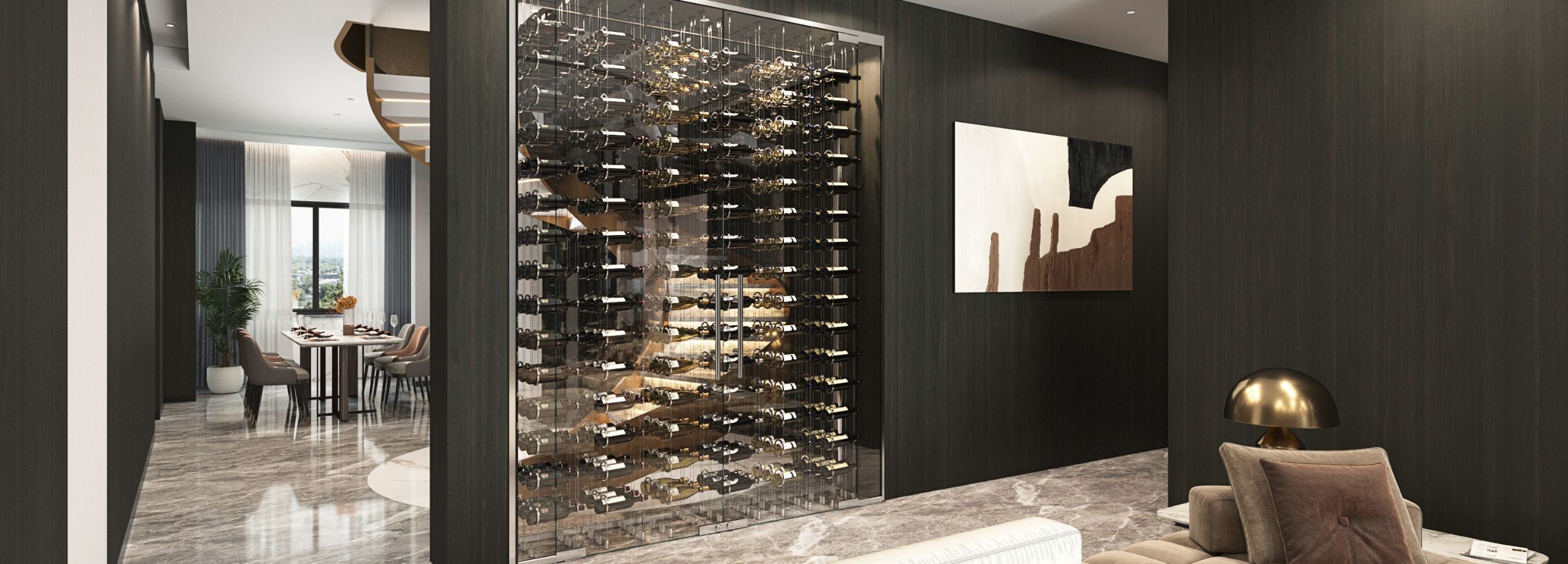
Wine Cellar Construction: Creating the Perfect Space for Your Wine Collection
Wine cellars offer the perfect environment for the storage and maturation of wines, affording you the opportunity to maintain your wine collection in impeccable condition. In this article, we will guide you through the process of building a wine cellar, from planning, to construction, to finishing touches.
Planning Your Wine Cellar:
Determine the Purpose:
The design and size of your wine cellar should reflect its purpose and make a statement about your passion for wine. It is essential to consider your intentions for the cellar before deciding on the design. If your primary goal is to store wine for aging, it is essential to invest in a wine cellar that provides a stable environment with consistent temperature and humidity levels. This will ensure that your wine ages gracefully and develops its full flavor potential over time.
If aging wine is not your goal, you have plenty of other design options to consider when creating your wine cellar. Wine cellar walls or glass-enclosed spaces can be an excellent alternative for showcasing your collection in a stylish and contemporary way. These designs not only provide easy access to your wine, but also create an elegant and visually stunning focal point in your home.
In our latest blog post, we have curated a range of unique design wine cellar ideas that are perfect for small and modern cellar spaces, providing inspiration for those who are looking to create a beautiful wine display without the need for a large wine cellar - “5 Wine Cellar Design Ideas for Small Spaces”.
Choose the Location:
Choose an appropriate location for your wine cellar that is cool, dark, and well-ventilated. The location should be away from direct natural light, heating ducts, or appliances that generate heat. A basement, a spare room or closet is an ideal location for a wine cellar. It is also recommended to choose a space that is easily accessible for stocking and retrieving wine, ensuring the utmost convenience in managing your wine collection.
Determine the Size:
To determine the size of your wine cellar, consider the number of wine bottles you currently own and how many you plan to add to your collection in the future. You will also need to consider the size of your wine bottles, as larger bottles, such as magnums, take up more space.
Once you have an estimate of the number of bottles you plan to store, you can determine the size of your wine cellar. A small wine cellar may be as little as 25 square feet, while a larger wine cellar can be several hundred square feet. Consider how much space you have available in your home, as well as your budget, when determining the size of your wine cellar. It's always better to build a wine cellar that's slightly larger than you think you will need, as it is easier to fill up the space than it is to expand it later on.
Complete Research about Wine Cellar Design Options:
Wine cellar design options are as diverse as the wines they store, offering an array of styles to suit every taste, budget, and space. From classic and traditional to modern and custom, the design possibilities are endless.
Classic/Traditional Design:
The classic and traditional wine cellar design is inspired by old-world European wine cellars. This design style is characterized by natural materials such as wood, stone, and brick, and often includes arches, vaulted ceilings, and intricate details. Classic wine cellar designs also feature large wooden racks or bins for wine storage, often arranged in a grid pattern.
Modern Design:
Modern wine cellars are typically characterized by sleek, clean lines and a minimalist aesthetic. Modern wine cellars often feature glass walls or doors, metal racks, and contemporary lighting fixtures. Wine racks in modern cellars may be made from metal or glass, and often have a minimalist design.
Rustic Design:
Rustic wine cellars are designed to evoke a sense of warmth and coziness. This design style is characterized by natural materials such as wood, stone, and brick, and often includes exposed ceiling beams and reclaimed wood accents. Rustic wine cellars often feature wine racks made from reclaimed wood or metal, and may include a tasting table or bar.
Contemporary Design:
Contemporary wine cellars are characterized by a blend of modern and traditional design elements. These cellars often feature clean lines, muted colors, and natural materials such as wood, stone, and metal. Wine racks in contemporary cellars may be made from wood, metal, or glass, and may have a modular or stacked design.
Custom Design:
Finally, for those who desire a one-of-a-kind wine cellar, custom design options are available. These cellars can be tailored to the individual's specific needs and preferences, incorporating features such as wine cellar temperature and humidity control, lighting, and custom wine racks.
Consider Your Budget:
Your budget will determine the materials, design, and features of your wine cellar. Some factors that can affect the cost of building a wine cellar include the type of cooling system, the type of wood and racking used, and the level of customization. Remember to determine your budget before starting your wine cellar project. With careful planning and consideration of your priorities, you can build a wine cellar that fits within your budget and meets your needs.
Preparing the Space for Your Wine Cellar:
Transforming a room into a wine storage space starts with understanding how to build a wine cellar correctly. Preparing the space for a wine cellar is an essential step in ensuring that your wine is stored in optimal conditions and free from air leaks. After selecting a suitable location, it is crucial to evaluate the space for potential challenges such as excessive moisture or inadequate ventilation. Careful consideration must be given to selecting appropriate materials for the exterior walls, ceiling, and floor to guarantee that the wine cellar remains insulated and free from moisture. The utilization of insulation and vapor barriers plays a pivotal role in regulating temperature and humidity levels, which are needful factors in ensuring the wine's quality.
Appropriate Conditions for Your Wine Collection:
Properly maintaining your wine cellar is critical for ensuring that your wine collection ages well and maintains its quality. The ideal conditions for wine storage are a consistent temperature, humidity, and air circulation. The ideal temperature for wine storage is 58 degrees Fahrenheit. Moreover, humidity control is essential to prevent corks from drying out and causing spoilage. The appropriate humidity level for wine storage is around 70%, which helps maintain the cork's moisture content and prevent air from entering the bottle.
In addition, proper ventilation is necessary to avoid musty odors and mold growth.
Monitoring and maintaining these conditions through appropriate interior walls insulation and cooling systems are crucial to ensure that your wine ages gracefully and retains its quality. With attention to these vital elements, you can create the ideal environment to store your wine and allow it to achieve its full potential.
Wine Cellar Construction:
Proper construction is essential for creating an environment that will protect your wine collection and maintain its quality. Here are some key considerations to keep in mind during the wine cellar construction process:
Choose the Right Wood:
One of the most important decisions you will make during this phase is the choice of wood for your wine cellar. The right wood is essential for your wine cellar, as it must be able to withstand high humidity levels and resist rot. Popular choices for wine cellars include cherry, walnut, and mahogany. Cherry is a popular choice due to its durability, natural resistance to rot, and insect-resistant properties. Walnut is also a good choice, as it has a natural resistance to moisture and insects. Mahogany is a dense hardwood that is strong and durable, with natural resistance to moisture.
Discover Genuwine Cellar’s expert guide: Best Wood for a Wine Cellar to learn more about differences in wood species.
Select appropriate Wine Racking and Shelving:
Choosing the right racking will allow you to store your wine collection safely and efficiently. Consider the size of your bottles, how you plan to organize your collection, and your budget.
First, think about the size of your wine bottles. You should choose racking that is appropriate for the size of your bottles, so they can be stored safely and securely. You may need to choose different sizes of racking for different types of bottles, such as standard 750ml bottles, magnums, or half bottles.
Next, consider how you plan to organize your wine collection. Do you want to display your bottles in a particular order, such as by region or varietal? Will you need extra space for large-format bottles, or for storing cases of wine? Take some time to think about your storage needs and choose racking and shelving that will accommodate them.
Your racking and shelving should complement the wood and other design elements in your cellar, creating a cohesive and visually appealing space. You may want to choose racking with a traditional, classic look, or opt for a more modern or contemporary style. There are many options available, so take some time to explore and choose racking and shelving that suits your taste and needs.
Install a Cooling System:
The right cooling system is crucial for maintaining the ideal temperature and humidity levels in your wine cellar. Options include ducted systems, self-contained, or ductless split systems.
Choosing the right wine cooling system is also essential to maintaining the ideal temperature and humidity for wine storage, as outlined in our blog post "How to Select the Right Cooling Unit". By selecting the appropriate system, wine collectors can ensure their wine is stored in optimal conditions for long-term aging and enjoyment.
Finishing Your Wine Cellar:
After completing the construction of your wine room or wine cellar and installing a suitable cooling system, it is time to direct your attention to the finishing touches that will elevate the functionality, sophistication, and overall allure of your delightful space.
Wine Cellar Doors:
When it comes to choosing a cellar door, there are several factors to consider. The material of the door can impact the insulation of the wine cellar, as well as the overall aesthetic. Solid wood doors are a popular choice for wine cellars, as they provide excellent insulation and can be customized to match the design of the room. Glass doors can also be used to showcase your wine collection. Consider investing in a well crafted glass wine door to secure your collection.
Explore the differences between each option by reading our blog post “Five Factors to Consider When Selecting a Wine Cellar Door”.
Lighting:
You need to be careful when choosing the type of lighting as it should not produce too much heat or ultraviolet light, which could harm your wine collection. Low-voltage or LED lights are the most popular options for wine cellars, as they are energy-efficient and do not produce too much heat. Rope lighting is also a great option to highlight the racking and create a soft ambiance.
Conclusion:
In conclusion, building a wine cellar is an investment in not just your wine collection, but also in the beauty and elegance of your home. By following the steps outlined in this guide, you can create a unique and sophisticated environment for storing and aging your wine collection. Remember to carefully plan and prepare your space, select the finest materials, and choose appropriate cooling systems, racking, shelving, and lighting to showcase your wine collection in the best possible light. With proper maintenance and organization, you can ensure that your wine cellar is a timeless addition to your home, enhancing its elegance and style for generations to come. Start building your wine cellar today and experience the exquisite pleasures of wine storage and appreciation at their finest.
Hire a Wine Cellar Professional
Employing the services of a wine cellar expert can be an exceedingly valuable investment, particularly for those who lack the requisite knowledge and expertise to construct a wine cellar themselves. An expert in the field can assist with all aspects of the process, from planning and design to material selection and construction. With a wealth of experience in the field, they can offer insightful guidance on the optimal conditions for wine storage, encompassing elements such as temperature, humidity, and ventilation. Furthermore, they can provide ongoing maintenance, lifetime warranty and support to ensure that your wine cellar remains in top condition for years to come.
Genuwine Cellars has nearly 30 years of experience in designing and building custom wine cellars, and our team of experts can work with clients to create a cellar that fits their specific needs and tastes. We understand that every wine collection is unique, and that's why we offer a variety of cellar styles, materials, and finishes to create a truly one-of-a-kind space.
Let us help you create a wine cellar that is not only functional but also a stunning work of art that reflects your love of wine.



